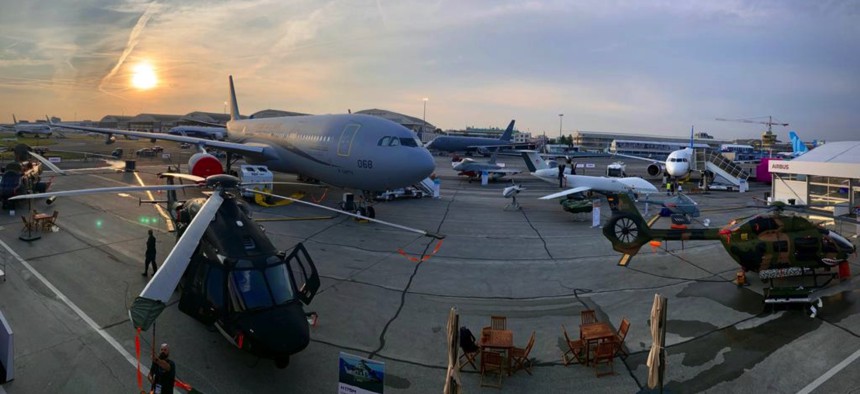
An Airbus A330—the airframe that Airbus and Lockheed aim to sell to the U.S. Air Force as a tanker—sits on the tarmac at the 2023 Paris Air Show. Airbus
On the Paris Tarmac, Execs Vie for the Next US Tanker Order
Boeing is trying to keep its monopoly, while Lockheed and Airbus seek a bigger pie.
LE BOURGET, France—At the far end of the tarmac here at the Paris Air Show, two gray aerial refueling tankers are parked within eyeshot of one another—prelude, perhaps, to going head-to-head for a double-digit order from the U.S. Air Force.
On one side of the ramp, a Boeing KC-46 is among a handful of U.S. military jets. Across the way, an Airbus A330 multi-role tanker transport is surrounded by other military aircraft. The two planes, each based on commercial airliners, are expected to compete as the U.S. Air Force looks to replace dozens of 60-plus-year old KC-135s.
Even though there is as yet no formal competition to replace those tankers, the planes’ makers are already digging in, with executives spending much of their time here touting their own jet.
“It doesn't make sense, at least from my perspective, to begin a new development program on a capability that's proven, that is still developing, and still improving both from a production perspective and a capability perspective,” said Ted Colbert, CEO of Boeing Defense, Space, and Security.
A few years ago, the Air Force said it planned to buy as many as 160 new tankers. Now, they say they only want 75 and will probably just buy an updated version of the Boeing-made KC-46, a tanker based on the company’s 767 airliner. The Air Force is already buying 179 KC-46 tankers from Boeing. Buying the same aircraft would likely reduce maintenance and logistics costs since most of the planes’ parts are the same.
The shrunken buy makes it harder for Airbus and its U.S. partner Lockheed Martin, which is leading the team. The companies need the Air Force to buy at least 110 planes for it to make business sense since the companies need to set up assembly lines in the United States, Greg Ulmer, executive vice president of Lockheed’s Aeronautics business said in an interview here.
Ulmer said Lockheed executives also pressed that message when Air Force acquisition chief Andrew Hunter toured the Airbus A330 tanker on the tarmac.
“I was very specific relative to that requirement,” he said. “It’s just the business case required.”
Airbus, which currently builds A330 aircraft here in France, plans to expand a facility in Mobile, Alabama, that currently builds smaller narrowbody aircraft. Lockheed then plans to convert the airliners into tankers in a Marietta, Georgia, factory where it already builds C-130s and part of the F-35.
The Air Force wants to buy fewer tankers, officials explained in March, because they have decided to buy an all-new tanker that can fly deeper into contested airspace and plug into next-gen battlefield networks. Called the next-gen aerial refueler, or NGAS, the Air Force wants this new plane to be flying by 2035.
“I think that’s a very aggressive date,” Ulmer said. “I think it’s more of a 2040 kind of date.”
Boeing’s Colbert said his company is working with the Air Force to understand “what that requirement is, what that approach to operational implementation looks like, and how we participate in that and then, obviously, we're investing in capabilities to support whatever that requirement looks like.”
Important features for next-gen refuelers include open mission systems, open architecture autonomy, and communications between allies and partners, and other products, he said.
Boeing also recently picked Aurora Flight Sciences, a subsidiary of Boeing, to lead the design of “composite components” that will protect future tankers against enemy weapons during aerial refueling missions.
“The KC-46A already features defensive systems that are unprecedented in a tanker,” Justin Hatcher, advanced technology director for Boeing’s KC-46 program, said in a statement Tuesday. “We continue to evolve the KC-46A and other next-generation refueling and mobility platforms to further enhance mission versatility and survivability.”
Aurora makes the composite skin for Boeing’s MQ-25—an unmanned aerial refueler used by the U.S. Navy—which gives the drone “lightweight strengthening and anti-corrosive benefits that are crucial for the carrier-based aircraft.”
Meanwhile, Ulmer touted the A330 tanker’s already-certified automated refueling system and its larger size, meaning it could fly longer distances or refuel more aircraft on a single flight. He also said the company’s Skunk Works division was experimenting with Joint All Domain Command and Control technology, which would connect all weapons on the battlefield, that could be installed on the tanker, which the company calls LMXT.
It’s been almost 20 years since the first battle between Boeing and Airbus tankers. That time Airbus, teamed with Northrop Grumman, won, until the Government Accountability Office said the Air Force’s 2008 evaluation was flawed. When the planes were reevaluated, the Air Force chose Boeing’s smaller 767-based tanker, now called the KC-46.
Boeing lowballed its bid—and that decision has come back to bite the company due to a myriad of technical and quality-control problems. The company is currently updating the tanker’s refueling system.
Boeing has struggled with KC-46 deliveries—which are still on hold due to a problem with the aircraft’s fuel tanks. Colbert declined to give a specific timeline for when deliveries will restart, but said, “We will resume delivering notwithstanding any other issue we find in the second half [of the year] if we have to and we've kept our commitment to that customer.”
The company announced that it lost $245 million on the KC-46 program in the first three months of 2023 due to a “supplier quality issue resulting in factory disruption and rework.” Boeing’s losses on the program now top $7 billion.
Despite all of these problems, the U.S. Air Force is flying KC-46 missions around the world.




